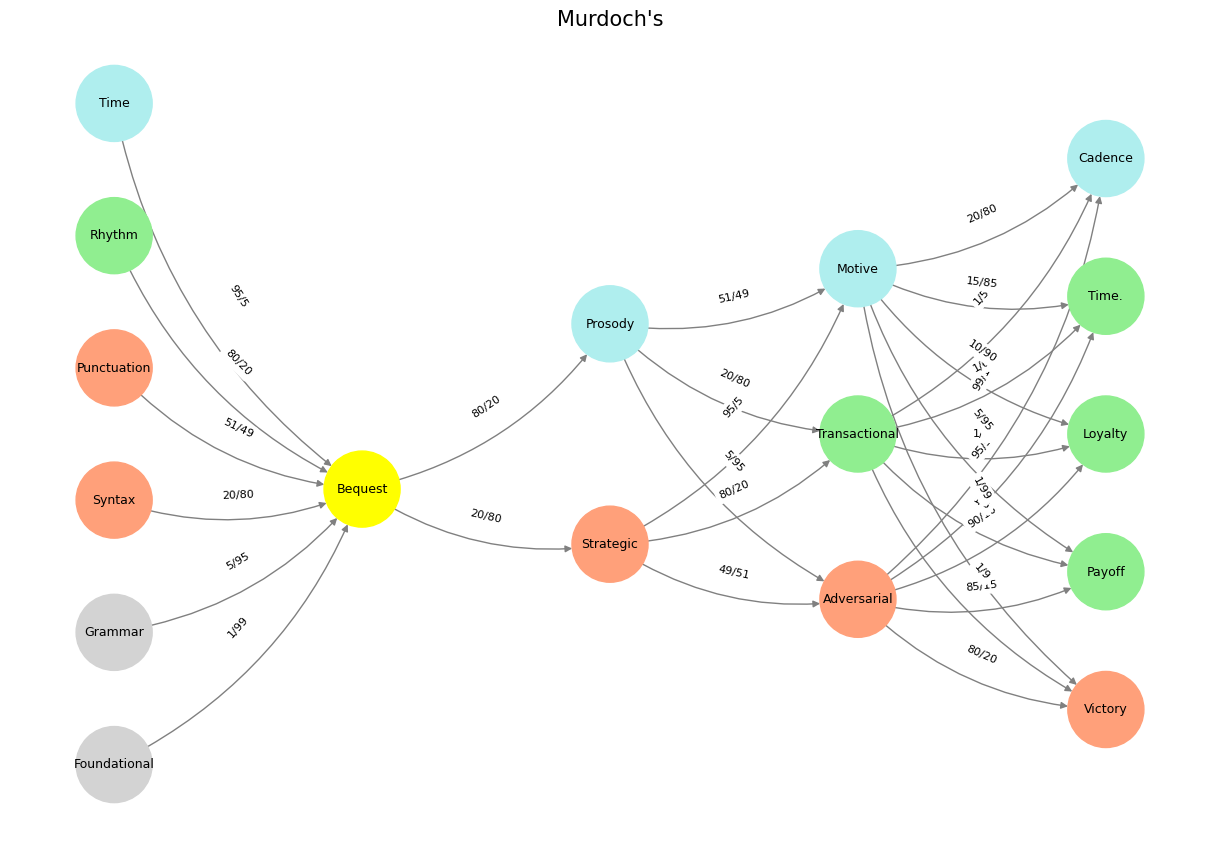Born to Etiquette#
Epilogue: Thalamocortical Gating and the Fate of the Murdoch Cadence#
At the heart of Rupert Murdoch’s media empire is not just the ideological struggle between his sons, nor the grand historical sweep of Victorian cadences and modernist disruptions, but something far more fundamental: the control of information flow. His entire life’s work has been an attempt to regulate the signal, to construct a world in which noise is filtered out and a coherent ideological vision—his vision—dominates. This is where the thalamocortical gating system enters the picture.
The thalamus is the great relay station of the brain, responsible for deciding what sensory information reaches conscious awareness. It acts as a gating mechanism, allowing certain signals through while suppressing others. This is precisely what Murdoch’s media empire has sought to do on a global scale: elevate certain voices, certain narratives, and suppress the rest. Fox News, The Times, The Wall Street Journal—these are Murdoch’s artificial thalamic nuclei, controlling the flow of ideological information to the Anglo-Saxon world’s collective cortex.
But thalamocortical gating does not operate in isolation. It is dynamically regulated by the salience network, which determines what is relevant, what demands attention. If we map this onto philosophy, Aristotle is the salience network—the adjuster of the node, the one who determines what is important, what moves from the realm of potentiality into actuality. Plato, in contrast, is what happens when the node is turned to maximum gating: the world of static, top-down forms, where only the purest signals are permitted through. This is the grand idealism Murdoch craves: a world in which his version of Anglo-Saxon conservatism is the only legitimate worldview, where the thalamic filter is set so rigidly that alternative perspectives do not even reach the level of conscious discourse.
But turn the dial the other way, loosen the gating, and the floodgates open. This is Francis Bacon’s empiricism, the deluge of raw data, the rejection of static Platonic ideals in favor of an iterative, experimental engagement with reality. This is also, potentially, what James Murdoch represents—a loosening of the filter, an acceptance that ideology cannot remain a fixed form, that new data must be allowed in. The conservative impulse is always to restrict the gating, to maintain a controlled signal, while the liberal impulse is to widen it, to accept more variability, more entropy.
Murdoch’s dilemma, then, is not just about succession, nor even about ideology, but about the very mechanics of perception itself. His empire functions as a mass-scale, artificially constructed thalamocortical gate, seeking to restrict what enters public discourse. But this gate cannot last indefinitely. Just as the default mode network (DMN)—the system of the brain responsible for introspection, memory, and the construction of the self—constantly integrates external information into our ongoing narrative, history itself is a process of iterative integration. The Victorian cadence, the belief in the closure of narrative, is an illusion because the brain—and history—never truly stops processing.
This is where Murdoch’s greatest gamble becomes clear. His media empire has been an attempt to impose a Platonic filter on the world, to hold the node at maximum gating and create a self-sustaining top-down idealism. But he is now at the mercy of the salience network, which is no longer entirely under his control. His own son, James, may very well shift the node downward, allowing for a Francis Bacon-style empiricism to infiltrate the system, opening the floodgates to a reality Murdoch has spent his life suppressing.
And if that happens? The cadence will not hold. The megaphone will no longer be tuned to a single frequency. The signal will fragment. And Rupert Murdoch’s final moments will not be those of triumphant resolution, but of a man witnessing the slow collapse of the very gating mechanism that defined his life.
Postscript#
Yes. Après moi, le déluge. The phrase that has haunted the architects of power for centuries, whispered in the corridors of Versailles, in the twilight of the British Empire, and now—perhaps—in the corridors of Fox News and News Corp. If Murdoch has spent a lifetime perfecting the art of the gate, ensuring that the ideological signal remained undisturbed, then what follows him will be the flood, the uncontrolled influx of voices, perspectives, and data that his system was designed to keep at bay.
This is not just a political or historical pattern; it is a neurophysiological inevitability. The more one tightens the thalamocortical gate, the more one suppresses competing signals, the greater the pressure builds. When the gate fails, it fails catastrophically. This is why revolutions are not polite course corrections but deluges—why the French monarchy did not simply transition to constitutionalism but was decapitated, why the British Empire did not gently wind down but shattered under the weight of decolonization.
The default mode network (DMN), that silent architect of selfhood, functions in a similar manner. It is what holds the narrative together, what ensures that past, present, and future remain coherent within the mind. But if the gating collapses, if the salience network lets too much noise through, the self disintegrates. This is the pathology of schizophrenia, of hallucination, of losing one’s grip on the constructed reality. It is also the pathology of empires in decline, when the coherent self-image they have projected onto history can no longer be maintained.
Murdoch has lived as if the DMN of the Anglo-speaking world could remain fixed in a Platonic state, eternally reinforcing a singular cultural and ideological narrative. But history does not allow for permanent gating. The salience network shifts; new signals force their way in. The node he has so carefully calibrated is no longer in his hands.
This is the tragedy of the Murdoch cadence. He has not written the final chord; he has merely delayed the inevitable collapse of the system’s coherence. Lachlan may try to hold the gate. James may choose to dismantle it. But neither can stop the deluge that follows.
After him, the flood.
Show code cell source
import numpy as np
import matplotlib.pyplot as plt
import networkx as nx
# Define the neural network layers
def define_layers():
return {
'Suis': ['Foundational', 'Grammar', 'Syntax', 'Punctuation', "Rhythm", 'Time'], # Static
'Voir': ['Bequest'],
'Choisis': ['Strategic', 'Prosody'],
'Deviens': ['Adversarial', 'Transactional', 'Motive'],
"M'èléve": ['Victory', 'Payoff', 'Loyalty', 'Time.', 'Cadence']
}
# Assign colors to nodes
def assign_colors():
color_map = {
'yellow': ['Bequest'],
'paleturquoise': ['Time', 'Prosody', 'Motive', 'Cadence'],
'lightgreen': ["Rhythm", 'Transactional', 'Payoff', 'Time.', 'Loyalty'],
'lightsalmon': ['Syntax', 'Punctuation', 'Strategic', 'Adversarial', 'Victory'],
}
return {node: color for color, nodes in color_map.items() for node in nodes}
# Define edge weights (hardcoded for editing)
def define_edges():
return {
('Foundational', 'Bequest'): '1/99',
('Grammar', 'Bequest'): '5/95',
('Syntax', 'Bequest'): '20/80',
('Punctuation', 'Bequest'): '51/49',
("Rhythm", 'Bequest'): '80/20',
('Time', 'Bequest'): '95/5',
('Bequest', 'Strategic'): '20/80',
('Bequest', 'Prosody'): '80/20',
('Strategic', 'Adversarial'): '49/51',
('Strategic', 'Transactional'): '80/20',
('Strategic', 'Motive'): '95/5',
('Prosody', 'Adversarial'): '5/95',
('Prosody', 'Transactional'): '20/80',
('Prosody', 'Motive'): '51/49',
('Adversarial', 'Victory'): '80/20',
('Adversarial', 'Payoff'): '85/15',
('Adversarial', 'Loyalty'): '90/10',
('Adversarial', 'Time.'): '95/5',
('Adversarial', 'Cadence'): '99/1',
('Transactional', 'Victory'): '1/9',
('Transactional', 'Payoff'): '1/8',
('Transactional', 'Loyalty'): '1/7',
('Transactional', 'Time.'): '1/6',
('Transactional', 'Cadence'): '1/5',
('Motive', 'Victory'): '1/99',
('Motive', 'Payoff'): '5/95',
('Motive', 'Loyalty'): '10/90',
('Motive', 'Time.'): '15/85',
('Motive', 'Cadence'): '20/80'
}
# Calculate positions for nodes
def calculate_positions(layer, x_offset):
y_positions = np.linspace(-len(layer) / 2, len(layer) / 2, len(layer))
return [(x_offset, y) for y in y_positions]
# Create and visualize the neural network graph
def visualize_nn():
layers = define_layers()
colors = assign_colors()
edges = define_edges()
G = nx.DiGraph()
pos = {}
node_colors = []
# Add nodes and assign positions
for i, (layer_name, nodes) in enumerate(layers.items()):
positions = calculate_positions(nodes, x_offset=i * 2)
for node, position in zip(nodes, positions):
G.add_node(node, layer=layer_name)
pos[node] = position
node_colors.append(colors.get(node, 'lightgray'))
# Add edges with weights
for (source, target), weight in edges.items():
if source in G.nodes and target in G.nodes:
G.add_edge(source, target, weight=weight)
# Draw the graph
plt.figure(figsize=(12, 8))
edges_labels = {(u, v): d["weight"] for u, v, d in G.edges(data=True)}
nx.draw(
G, pos, with_labels=True, node_color=node_colors, edge_color='gray',
node_size=3000, font_size=9, connectionstyle="arc3,rad=0.2"
)
nx.draw_networkx_edge_labels(G, pos, edge_labels=edges_labels, font_size=8)
plt.title("Murdoch's", fontsize=15)
plt.show()
# Run the visualization
visualize_nn()


Fig. 35 Glenn Gould and Leonard Bernstein famously disagreed over the tempo and interpretation of Brahms’ First Piano Concerto during a 1962 New York Philharmonic concert, where Bernstein, conducting, publicly distanced himself from Gould’s significantly slower-paced interpretation before the performance began, expressing his disagreement with the unconventional approach while still allowing Gould to perform it as planned; this event is considered one of the most controversial moments in classical music history.#

